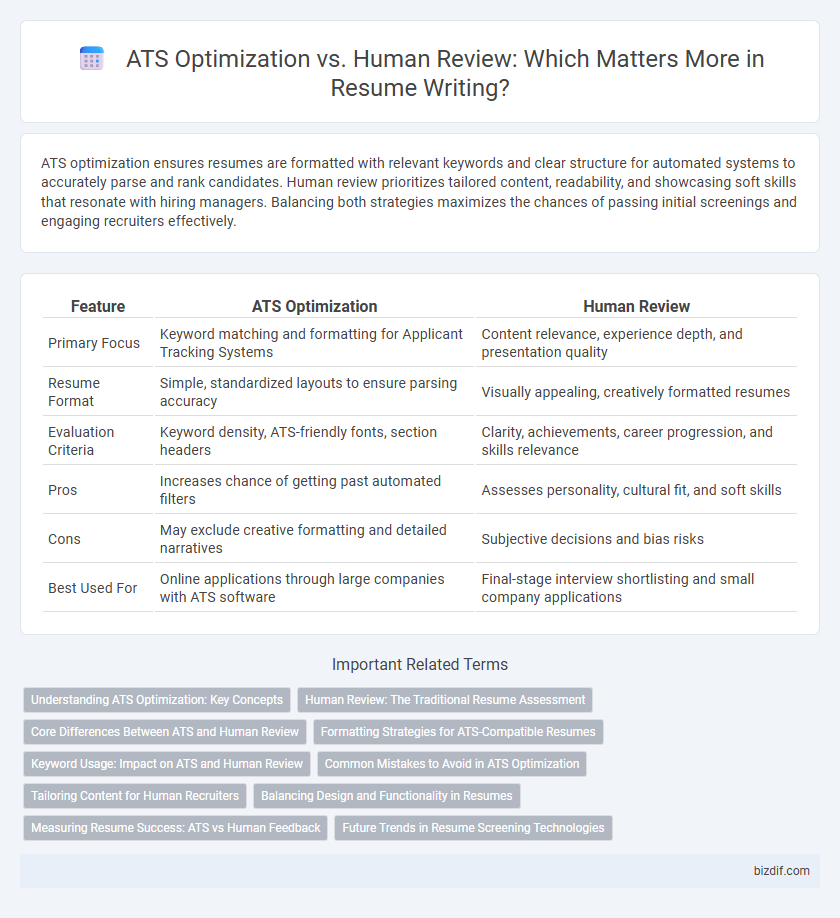ATS optimization ensures resumes are formatted with relevant keywords and clear structure for automated systems to accurately parse and rank candidates. Human review prioritizes tailored content, readability, and showcasing soft skills that resonate with hiring managers. Balancing both strategies maximizes the chances of passing initial screenings and engaging recruiters effectively.
Table of Comparison
| Feature | ATS Optimization | Human Review |
|---|---|---|
| Primary Focus | Keyword matching and formatting for Applicant Tracking Systems | Content relevance, experience depth, and presentation quality |
| Resume Format | Simple, standardized layouts to ensure parsing accuracy | Visually appealing, creatively formatted resumes |
| Evaluation Criteria | Keyword density, ATS-friendly fonts, section headers | Clarity, achievements, career progression, and skills relevance |
| Pros | Increases chance of getting past automated filters | Assesses personality, cultural fit, and soft skills |
| Cons | May exclude creative formatting and detailed narratives | Subjective decisions and bias risks |
| Best Used For | Online applications through large companies with ATS software | Final-stage interview shortlisting and small company applications |
Understanding ATS Optimization: Key Concepts
ATS optimization involves tailoring resume content with relevant keywords, standardized formatting, and clear headings to ensure compatibility with Applicant Tracking Systems used by employers. Understanding key concepts like keyword density, ATS-friendly fonts, and avoiding complex graphics increases the likelihood of a resume passing automated scans. Proper ATS optimization bridges the gap between digital parsing algorithms and human reviewers by prioritizing both machine readability and meaningful content.
Human Review: The Traditional Resume Assessment
Human review remains the cornerstone of traditional resume assessment, relying on recruiters' expertise to interpret context, soft skills, and nuanced achievements that ATS algorithms often overlook. Recruiters evaluate resumes based on formatting, relevance, and storytelling to determine cultural fit and candidate potential beyond keyword matching. This personalized approach highlights qualitative factors essential for making informed hiring decisions in competitive job markets.
Core Differences Between ATS and Human Review
ATS optimization relies on keyword matching, standardized formatting, and score-based algorithms to filter resumes quickly, focusing on relevance to the job description. Human review prioritizes qualitative assessment, evaluating soft skills, experience nuances, and overall candidate fit beyond keywords. Understanding these core differences ensures resumes are tailored to pass ATS scans while appealing to recruiters' thorough evaluations.
Formatting Strategies for ATS-Compatible Resumes
Effective ATS-compatible resume formatting involves using standard fonts like Arial or Times New Roman, clear section headings, and simple bullet points to ensure readability by applicant tracking systems. Avoiding images, graphics, and complex tables enhances the parsing accuracy of ATS software, preventing crucial information from being lost. Using consistent formatting with appropriate keywords aligned to the job description increases the chances of passing both ATS algorithms and human reviewers.
Keyword Usage: Impact on ATS and Human Review
Effective keyword usage significantly enhances resume visibility in ATS by matching applicant data with job descriptions, ensuring initial screening success. Strategic incorporation of industry-specific terms and relevant skills improves human reviewers' ability to quickly assess qualifications and job fit. Balancing keyword density prevents ATS rejection for keyword stuffing while maintaining readability for recruitment professionals.
Common Mistakes to Avoid in ATS Optimization
Common mistakes to avoid in ATS optimization include overusing keywords, which can trigger filters flagging the resume as spam, and neglecting to customize the resume for each job description, reducing relevance to specific roles. Formatting errors like using tables, graphics, or unusual fonts can cause parsing issues, leading to key information being overlooked by ATS software. Ensuring clear section headings and standard fonts improves readability for both ATS and human reviewers, optimizing the resume's chances of advancing in the hiring process.
Tailoring Content for Human Recruiters
Tailoring resume content for human recruiters involves using clear, concise language and emphasizing relevant achievements with quantifiable results. While ATS optimization requires keyword integration, human reviewers prioritize coherence, readability, and the demonstration of soft skills and cultural fit. Balancing ATS-friendly formatting with engaging content ensures that resumes resonate effectively during the human review process.
Balancing Design and Functionality in Resumes
Balancing design and functionality in resumes ensures compatibility with Applicant Tracking Systems (ATS) while appealing to human reviewers. Strategic use of keywords, clean formatting, and clear section headings enhance ATS optimization without sacrificing visual appeal. Prioritizing readable fonts and minimalistic design helps maintain professionalism and increases the chances of passing both digital scans and human evaluation.
Measuring Resume Success: ATS vs Human Feedback
Measuring resume success involves comparing ATS optimization metrics, such as keyword match rates and parsing accuracy, with human feedback on content clarity and relevance. High ATS scores ensure resumes pass initial screenings, but positive human reviews highlight the resume's impact during interviews. Balancing both approaches maximizes visibility and effectiveness in the hiring process.
Future Trends in Resume Screening Technologies
Future trends in resume screening technologies emphasize enhanced integration of AI and machine learning algorithms to improve ATS optimization alongside human review processes. These advancements aim to reduce bias, increase accuracy in candidate matching, and enable real-time adaptability to job market demands. Emerging systems will likely blend semantic analysis with predictive analytics to streamline talent acquisition and elevate recruitment effectiveness.
ATS Optimization vs Human Review Infographic

 bizdif.com
bizdif.com